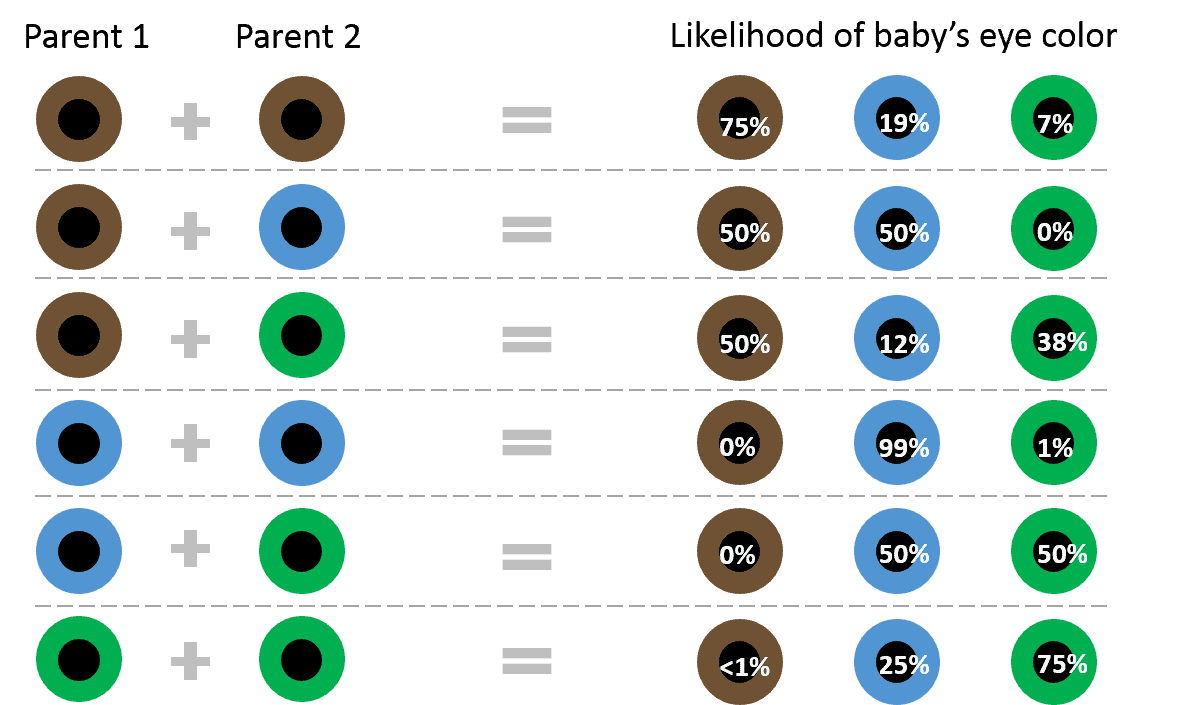It is said that the eyes are the doorway to the heart; a reflection of our inner self and emotions. Countless poets, writers, and artists praise this unique quality. Regardless of whether or not all of this is true, one of the first things we certainly notice about people around us is their eye color.
Have you ever wondered why your eyes are the color they are? Or have you ever marveled at the striking blue eyes of a friend or loved one? The color of our eyes is determined by genetics, and is influenced by the amount and type of pigments in our irises, as well as by the scattering of light by the turbid medium in our eyes.
Actually, all the magic happens within the colored part of the eye: the iris.
The genetics that gives eyes their color
The only colored part of the eye is the iris, which is where we’ll focus our attention for now. The iris color is determined by the amount of melanin pigmentation. The more melanin there is, the darker the iris will be. Blue, gray, and green eyes are lighter because there is less melanin inside the iris.
By far, the most common eye color in the world is brown, with over 55% of the population falling into this category. Depending on where a person is born, eye color demographics can vary wildly. For instance, nearly all persons of African and Asian ancestry have brown eyes. It’s believed up to 10,000 years ago, all humans had brown eyes only, but subsequent mutations introduced new eye color variations.
The second-most common eye color is blue, represented by 8% to 10% of the world’s population. All blue eyes today can be traced back to a single common ancestor that spontaneously developed the mutation for this eye color, according to researchers at the University of Copenhagen. The mutation spread from that ancestor across the globe over the last 6 to 10 millennia.
Hazel eyes are similar to brown eyes, the distinction being these are lighter, meaning they contain a tad less melanin. A defining trait of hazel eyes is their multi-colored appearance which can vary from copper to green depending on the lighting. Estimates suggest 5% to 8% of the world’s population is hazle-eyed (both green and brown).
Amber eyes or ‘wolf eyes’ as they’re sometimes called, are completely solid and have a strong yellowish, golden, or russet and coppery tint. They can also contain a small amount of gold-ish gray. It’s not clear how amber eyes form but some suggest it’s due to the increased presence of a pigment called lipochrome (also known as pheomelanin).
Lastly, people with albinism, a condition that causes a complete lack of or very low levels of pigment in the skin, hair, and eyes, sometimes appear to have violet or red eyes. That’s because these individuals essentially lack any pigment in the iris, so light simply bounces off the back of the eye where it hits blood vessels, so the iris looks red. The same light-scattering effects can also explain why you sometimes appear red-eyed in photos.
| Eye Color | Percentage of Population |
|---|---|
| Brown | 55%-80% |
| Blue | 8%-10% |
| Green | 2% |
| Hazel | 5% |
| Gray | 1% |
When we come into this world, our eyes are blue or almost colorless. This is true for all babies, no matter their ancestry. In time, the concentration of melanin increases, and by age three, the eyes will have darkened to their true, final resting color. Or almost final. Much later in life, our eyes can change color once more. Disease and trauma can also inflict changes in iris coloring.
How eye color is inherited

If both parents have blue eyes, there’s a good chance their offspring has blue eyes as well. It follows that iris coloring is governed by genetics. However, a baby’s eye color doesn’t come out as a blend of the parent’s eye, like you would mix paint on an art board.
Up until not too long ago, even doctors used to think that eye color was determined by a single gene and followed a simple inheritance pattern in which brown eyes were dominant to blue eyes. The thinking was that if two parents both had blue eyes, they couldn’t make a baby with brown eyes. Imagine what sort of problems this caused back at home when this prediction did. Alas, this is wrong.
In reality, eye color is a polygenic trait, meaning that it is determined by multiple genes. The genes responsible for eye color are located on chromosome 15, and are referred to as the OCA2 and HERC2 genes. The OCA2 gene codes for the production of melanin, a pigment that determines the color of our eyes, skin, and hair. The HERC2 gene regulates the expression of the OCA2 gene.
In the European population, a common polymorphism in HERC2 gene is responsible for the blue eye phenotype. A person who has two copies of C allele at HERC2 rs1293832 will likely have blue eyes while homozygous TT predicts likely brown eyes. Mutations in OCA2 result in oculocutaneous albinism, a condition associated with vision problems such as reduced sharpness and increased sensitivity to light.
The inheritance of eye color is complex, and the contribution of each parent’s genes to the child’s eye color is not always equal. But in general, brown eye color is dominant over blue eye color, and green eye color is a mixture of blue and brown. However, the specific amount of each color that a child will inherit from their parents is difficult to predict.
| Parent 1 Eye Color | Parent 2 Eye Color | Possible Eye Colors for Child |
|---|---|---|
| Brown | Brown | Brown, Green, Blue |
| Brown | Blue | Brown, Green, Blue |
| Brown | Green | Brown, Green, Blue |
| Blue | Blue | Blue, Green |
| Blue | Green | Green, Blue |
| Green | Green | Green, Blue |
Several other genes play smaller roles in determining eye color. Some of these genes are also involved in skin and hair coloring. Genes with reported roles in eye color include ASIP, IRF4, SLC24A4, SLC24A5, SLC45A2, TPCN2, TYR, and TYRP1. The effects of these genes likely combine with those of OCA2 and HERC2 to produce a spectrum of possible eye color inheritance.
In addition to the amount of melanin in the iris, the scattering of light by the turbid medium in our eyes can also affect the perceived color of our eyes. The turbid medium is the layer of cells and proteins in the front part of the eye that helps to focus light on the retina. When light enters the eye, it is scattered by the turbid medium, and the color of our eyes is determined by the wavelengths of light that are absorbed or reflected.
For example, blue eyes appear blue because the turbid medium in the eye absorbs shorter wavelengths of light, such as blue and violet, and reflects longer wavelengths, such as green and yellow. Green eyes appear green for the same reason, but the turbid medium in green eyes reflects a higher percentage of green light and a lower percentage of blue light. Brown eyes appear brown because the turbid medium absorbs all wavelengths of light, resulting in a dark color.
How eye color changes with age
The iris, the colored bit of the eyes, is essentially a muscle. Its role is to control pupil size so we can see better under varying lighting conditions. When there’s dim light, the pupils enlarge and, conversely, grow smaller in bright lighting. Pupils also change size when we focus on objects at varying distances. For instance, reading a book requires your pupils to shrink in order to focus on the words inked on the paper very close to the eyes.
When the pupil’s size changes, the melanin pigment is compressed or spread apart, slightly changing the eye color. The effect is minuscule but it’s there.
Some have suggested that mood can also change eye color. While it’s true certain emotions like anger or love can influence pupil size, the iris doesn’t really change color. When a person’s eyes have red, dilated blood vessels from an angry outburst, their eyes may appear to be greener because of the contrast, but this is just a matter of perception.
Eye color can permanently change over the course of one’s life, though. For 10 to 15 percent of the Caucasian population, iris color changes with age. This is why some people’s eye color may appear to change from brown to hazel or green as they get older. This is completely normal but if such a change in eye color happens fast and dramatically, like from brown to green or from blue to brown, this may be a sign of concern making a doctor’s appointment urgently required. Eye color changes can be a warning sign of certain diseases, such as Fuch’s heterochromic iridocyclitis, Horner’s syndrome, or pigmentary glaucoma.
Eye color is a fascinating genetic trait that is determined by multiple genes and influenced by the amount of melanin in the iris and the scattering of light by the turbid medium in our eyes. The inheritance of eye color is complex and can be difficult to predict, and a variety of factors, including age and medical conditions, can cause a person’s eye color to change over time. Whether you have striking blue eyes or deep brown eyes, the color of your eyes is a unique and beautiful aspect of your genetics.








